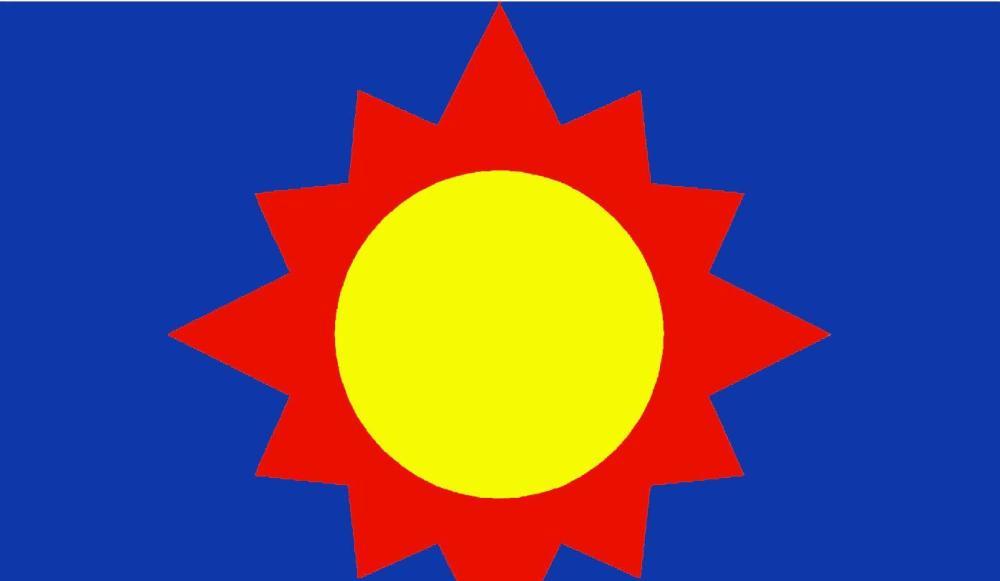The national flag is a kind of iconic flag of the country, is the symbol of the country, it reflects the characteristics and historical and cultural traditions of a country through a certain style of color and pattern, at the beginning this custom originated in the West, and with the modern spread to China, after the founding of New China, our national flag is a bright five-star red flag, and before that, there were also several regimes that had alternately evolved, and the 5 national flags designed after the Ming Dynasty, each of which is unique, you know a few

The first is the "Sun and Moon Banner" of the Ming Dynasty, which appeared in the Ming Dynasty's foreign trade activities, from the "Biography of Mu Tianzi": "The Flag of the Sun and The Moon, the Text of the Seven Stars". Because of the nationality convention at that time, the Portuguese and the Dutch all hung a national flag in the penetration of merchant ships, which was conducive to the difference between the sea, so the Ming Dynasty Merchant Shipping Association also uniformly stipulated that hanging a sun and moon flag on the ship to represent this was the Ming Dynasty, but this was not officially recognized, so the sun and moon flag seen today is somewhat different.
The first national flag in Chinese history should be the Yellow Dragon Flag of the Qing Dynasty, which was selected from the totem dragon of the Chinese nation as the main body. After the Western powers opened the door of the Qing Dynasty with a cannon, the Qing government also understood the importance of integration into the international community, so it designed this flag, so on October 17, 1862, the Qing court approved the premier Yamen's permission, and all the ships of the marine division were hung with the triangular Yellow Dragon Flag as the official ship flag. Originally, the flag of the Qing Dynasty was still triangular, but later it was still not very convenient, so it was changed to a rectangular flag with a height of three feet and a height of four feet. On October 3, 1888, Empress Dowager Cixi approved the Beiyang Naval Charter, which stipulated that the flag of the Qing Dynasty was a rectangular yellow dragon flag, at which time the national flag was officially determined.
In a sense, the flag of the Qing Dynasty was more complex, and the purpose of the national flag was more concise and clear, so later the Chinese flag was more concise, after the Wuchang Uprising, the revolutionaries briefly used the iron-blooded Eighteen Star Army Flag as the national flag, the pattern consisted of a red background, a black nine-wheeled horn and 18 small yellow round stars. The red background and black nine wheels symbolize the spirit of iron blood, indicating the determination to overthrow the Qing Dynasty by force, and it is this kind of flag that appears in the movie "Let the Bullets Fly".
The five-color flag was originally the flag of the general of the Beiyang Navy of the Qing Dynasty, "the admiral used a five-color rectangular flag; the generals used a three-color rectangular flag; the upper corner of the flag, each decorated with an anchor." For example, if the flag of other national flags is woven in the same style in the future, the style shall be changed by the Navy Yamen at its discretion. After the outbreak of the Xinhai Revolution, the Beiyang government positioned the five-color flag as the national flag, the face was in order of red, yellow, blue, white, black five-color horizontal strips, red, yellow, blue, white, black five colors respectively represented the Han, Manchu, Mongolian, Hui, Tibetan, the five colors selected for the five ethnic groups traditionally favorite colors, symbolizing the republic of the five ethnic groups.
The Qingtian White Sun Flag was the first banner formulated by the Xinhai Revolution, designed by Lu Haodong, a member of the Xingzhong Association, and later used as a party flag by the Kuomintang that inherited the Xingzhong Association, and the flag was blue to show the blue sky; in the middle of the flag, a white sun pattern that shot out a forked light was placed in the middle of the flag. Immediately after 1925, the Nationalist government adopted this flag as the flag of the Republic of China.
Because the Republic of China was in an era of relatively divided territory and warlords, there were some small warlords at that time, and they also had their own self-made banners, as well as the Wang Jingwei puppet regime established with the support of the Japanese during the War of Resistance Against Japanese Aggression, and also had its own flags.